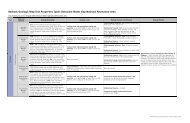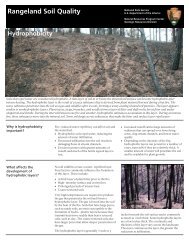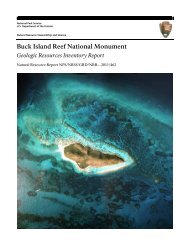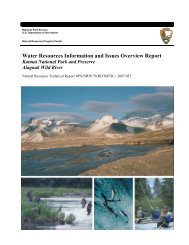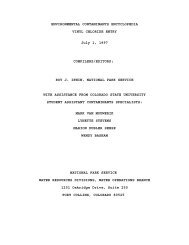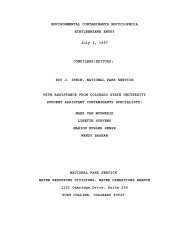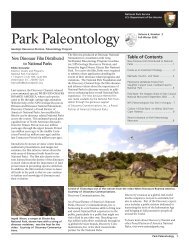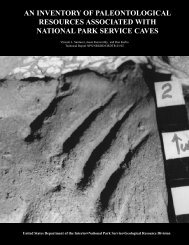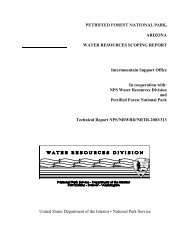toluene - National Park Service
toluene - National Park Service
toluene - National Park Service
Create successful ePaper yourself
Turn your PDF publications into a flip-book with our unique Google optimized e-Paper software.
Perchloroethylene enhances toxicity of <strong>toluene</strong> admin orally in<br />
rats. [Smyth HF et al; Amer Ind Hyg Assoc J 30 (5): 470-6<br />
(1969) as cited in USEPA; Health Assessment Document: Toluene<br />
p.15-1 (1982) EPA-800/8-82-008<br />
Toluene and trichloroethylene seem to exhibit competitive<br />
inhibition. [Ikeda M; Int Arch Arbeitsmed 33 (2): 125 (1974).<br />
CFY rats ... on day 12 of pregnancy ... dams were given: 0,<br />
125, 250, 500 and 3,600 mg/cu m ... and 250 mg/kg<br />
acetylsalicylic acid by gavage; two subgroups ... treated with<br />
250 mg/kg acetylsalicylic acid in combination with 3,600 mg/cu<br />
m <strong>toluene</strong> inhalation were given 0, 2.5, or 5 gm/kg glycine 2<br />
hours before the acetylsalicylic acid dose. ... Toluene was<br />
found to potentiate the toxic effect of acetylsalicylic acid<br />
and to increase both maternal and embryonic toxicity ...<br />
increasing acetylsalicylic acid embryotoxicity caused by<br />
<strong>toluene</strong> can be warded off by glycine administration. [Ungvary<br />
G et al; Teratology 27 (2): 261-9 (1983).<br />
The metabolism of <strong>toluene</strong> was found to be inhibited by a large<br />
dose of alcohol in 7 volunteers exposed to 80 ppm. ... When<br />
alcohol was taken during exposure, blood <strong>toluene</strong> concns were<br />
42-45% greater on average than during exposure with no<br />
alcohol. ... These results suggest that continued alcohol<br />
intake increases the metabolism of <strong>toluene</strong>, presumably by<br />
inducing the microsomal oxidizing enzyme system in the liver.<br />
[Waldron HA et al; Int Arch Occup Environ Health 51 (4): 365-9<br />
(1983).<br />
The metabolic interaction of <strong>toluene</strong> and ethanol was studied<br />
in male rabbits having received ethanol (26.0 mmol/kg po),<br />
<strong>toluene</strong> (5.4 mmol/kg po) or both. Compared with ethanol alone,<br />
<strong>toluene</strong> given 2 hr after ethanol caused a significantly higher<br />
and more prolonged concentration of blood alcohol. A similar<br />
trend of blood alcohol was observed at the later stage with<br />
<strong>toluene</strong> given prior to ethanol. On the other hand, with<br />
simultaneous doses of the two substances, the blood <strong>toluene</strong><br />
concentration was higher for the first 15-30 min than the<br />
ethanol control and the urinary excretion of hippuric acid, a<br />
main metabolite of <strong>toluene</strong>, was markedly decreased for the<br />
first 2 hr. The blood ethanol in this group, on the contrary,<br />
was reduced until 1 hr after administration. These results<br />
indicate that <strong>toluene</strong> and ethanol act reciprocally as<br />
competitive inhibitors in their metabolism after single<br />
administrations. [Takahashi S et al; Arch Toxicol 59 (5):<br />
307-10 (1987).<br />
In an experimental human study, the effect of <strong>toluene</strong> and<br />
ethanol (alone or in combination) on psychophysiologic<br />
functions was studied in 12 men (22-44 yr of age). Each<br />
subject served as his own control. Subjects were exposed to<br />
<strong>toluene</strong> by inhalation at a concentration of 300 mg <strong>toluene</strong>/cu<br />
m air for 4.5 hr. Ethanol was ingested at a dose equivalent to



